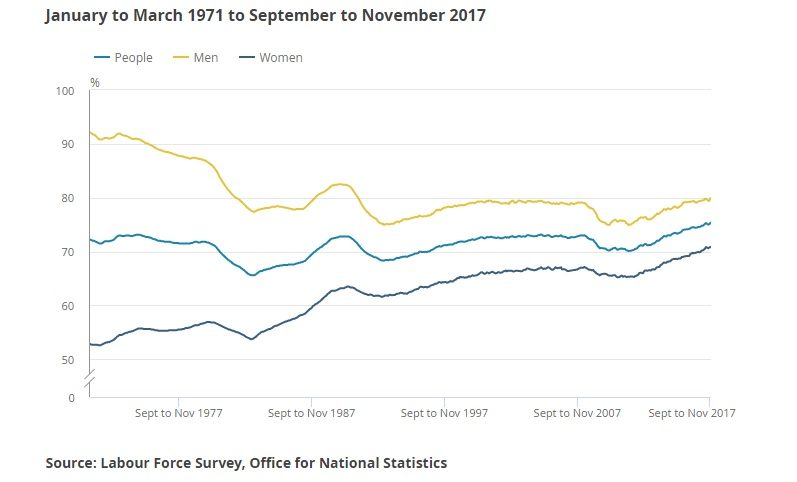The UK labor market proved to be very resilient to Brexit-related economic shakeup with some labor market characteristics rising to the modern era maximum. The unemployment rate sits steady at the lowest level since 1975 of 4.3% since July last year and the employment rose to the highest level since comparable records began in 1971 at 75.3%. The unemployment rate is expected to remain steady at 4.3% on three months moving average basis for the month of December as well.
Key labor market indicator in the UK in terms of economic potential is the average weekly wage growth, that is rising below the level of inflation since January 2017 when the growth rate of took over the nominal wage growth. For the remainder of last year, the inflation rate in the UK remained elevated peaking at 3.1% in November 2017.
Latest estimates from the Office for National Statistics show that average weekly earnings for employees in the UK increased by 2.5% y/y including bonuses and by 2.4% y/y excluding bonuses. After the inflation adjustment, the average weekly earnings for employees in Great Britain in real terms fell by 0.2% over the year including bonuses and fell by 0.5% over the year when bonuses are excluded. Negative real wage growth is, therefore, weighing on stagnant retail sales as well as diminishing overall economic growth.
The average regular pay excluding bonuses for the September to November 2017 period for employees in the UK was £480 per week before tax and other deductions from pay, up from £469 per week for a year earlier. At the same time, the average weekly pay was £511 including bonuses.
With fresh labor market report in February, the average nominal wage growth rate is expected to also remain steady at 2.4% after excluding bonuses for the three months ending in December average. With inflation in December ticking slightly lower, but still elevated at 3.0% y/y, the negative real wage growth in the UK is set to persist further.
The structure of the UK employment changes with the proportion of jobs accounted for by the manufacturing and mining and quarrying sectors falling from 26.4% in June 1978 to 7.8% in September to November 2017, while a portion of jobs in services rose from 63.2% to 83.4% at the same time.
The signs of a relative slowdown of wage growth would be perceived by markets negatively and Sterling would be under selling pressure. The same applies to the unemployment rate that is similar to wages reported on a three months average basis. With the claimant count rising almost 15K for the last 12 months, indicating that the underlying job creation and labor market slack absorption has already ended in 2017.
Note: All information on this page is subject to change. The use of this website constitutes acceptance of our user agreement. Please read our privacy policy and legal disclaimer. Opinions expressed at FXstreet.com are those of the individual authors and do not necessarily represent the opinion of FXstreet.com or its management. Risk Disclosure: Trading foreign exchange on margin carries a high level of risk, and may not be suitable for all investors. The high degree of leverage can work against you as well as for you. Before deciding to invest in foreign exchange you should carefully consider your investment objectives, level of experience, and risk appetite. The possibility exists that you could sustain a loss of some or all of your initial investment and therefore you should not invest money that you cannot afford to lose. You should be aware of all the risks associated with foreign exchange trading, and seek advice from an independent financial advisor if you have any doubts.
Recommended Content
Editors’ Picks
AUD/USD failed just ahead of the 200-day SMA

Finally, AUD/USD managed to break above the 0.6500 barrier on Wednesday, extending the weekly recovery, although its advance faltered just ahead of the 0.6530 region, where the key 200-day SMA sits.
EUR/USD met some decent resistance above 1.0700

EUR/USD remained unable to gather extra upside traction and surpass the 1.0700 hurdle in a convincing fashion on Wednesday, instead giving away part of the weekly gains against the backdrop of a decent bounce in the Dollar.
Gold stays firm amid higher US yields as traders await US GDP data

Gold recovers from recent losses, buoyed by market interest despite a stronger US Dollar and higher US Treasury yields. De-escalation of Middle East tensions contributed to increased market stability, denting the appetite for Gold buying.
Ethereum suffers slight pullback, Hong Kong spot ETH ETFs to begin trading on April 30

Ethereum suffered a brief decline on Wednesday afternoon despite increased accumulation from whales. This follows Ethereum restaking protocol Renzo restaked ETH crashing from its 1:1 peg with ETH and increased activities surrounding spot Ethereum ETFs.
Dow Jones Industrial Average hesitates on Wednesday as markets wait for key US data

The DJIA stumbled on Wednesday, falling from recent highs near 38,550.00 as investors ease off of Tuesday’s risk appetite. The index recovered as US data continues to vex financial markets that remain overwhelmingly focused on rate cuts from the US Fed.
